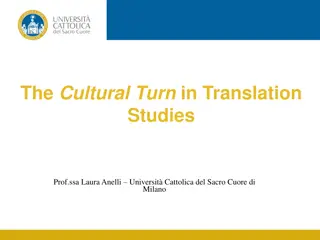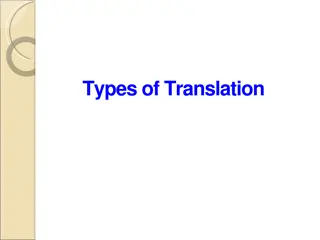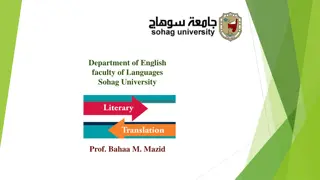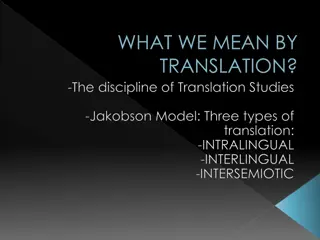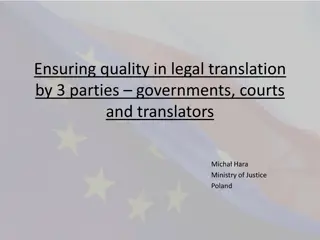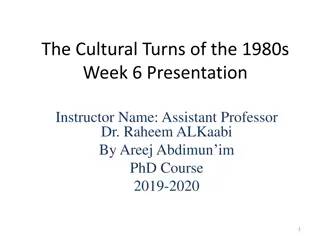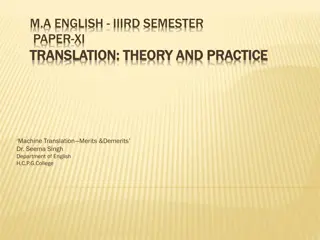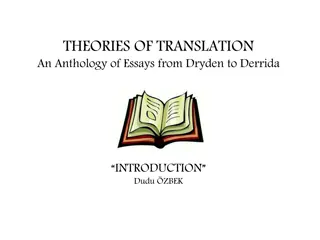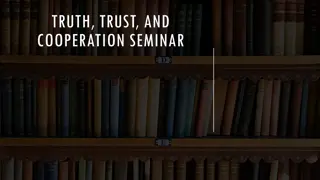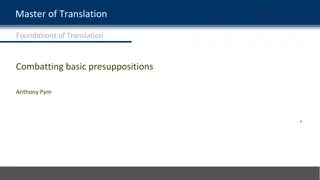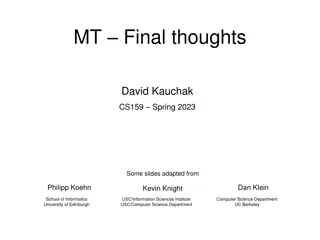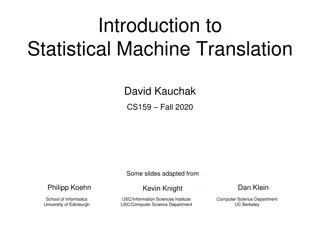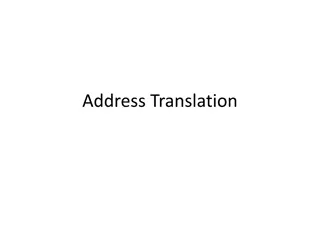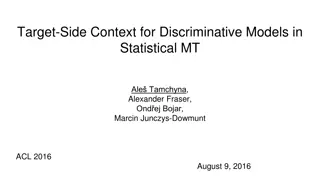Translation: Key Concepts and Definitions
Translation involves transferring written text from one language to another, while interpreting deals with oral communication. Etymologically, the term "translation" comes from Latin meaning "to carry over." It is a process of replacing an original text with another in a different language. Translation aims to convey the meaning accurately between source and target languages. The process involves changing written text from source language to target language. When translating, the source language is English and the target language is defined. Translation is about replacing text in one language with equivalent material in another language.
Download Presentation

Please find below an Image/Link to download the presentation.
The content on the website is provided AS IS for your information and personal use only. It may not be sold, licensed, or shared on other websites without obtaining consent from the author.If you encounter any issues during the download, it is possible that the publisher has removed the file from their server.
You are allowed to download the files provided on this website for personal or commercial use, subject to the condition that they are used lawfully. All files are the property of their respective owners.
The content on the website is provided AS IS for your information and personal use only. It may not be sold, licensed, or shared on other websites without obtaining consent from the author.
E N D
Presentation Transcript
Translation Department First Year Classes Module Tutor: Dr. Yousif Ali Omer 2022-2023
It is important to stress that translation deals with the transfer of written text. When the text or the medium is oral, however, the term used is interpreting or interpretation.
Etymologically, The English term "translation" derives either from the Old French translation or more directly from the ('transporting'), itself Latin translatio coming from the participle of the verb transferre ('to carry over').
What is translation? What is translation? Translation is a procedure where an original text, often called the source text , is replaced by another text in a different language, often called the the target text . (House, 2018)
Translation refers to the process of rendering/transferring the meaning of the source language text into the target language as closely, completely and accurately as possible,
The process of translation between two different written languages involves the changing of an original written text (the source text or ST) in the original verbal language (the source language or SL) into a written text (the target text or TT) in a different verbal language (the target language or TL): Source in Source text in source text (ST) language (SL) (ST) (SL) Target in Target text in target text (TT) language (TL) (TT) (TL) source language target language (Munday, 2016)
He is a smart student. (SL) (TL) Thus, when translating this English sentence into Kurdish, the ST is English and the TT is Kurdish.
Translation is the replacement of textual material in one language (Source Language) by equivalent material in another language (Target Language). (Catford 1965:20)
Nida (1965)suggests that translation is concerned with the reproduction of the closest equivalent of the source language text (or textual material) in the target language.
Translation is defined as rendering the meaning of a text into another language in the way that the author intended the text (Newmark, 1988, p. 5);
Translate the following sentences into Kurdish. 1. I study Translation at the Salahaddin University - Erbil. 2. Translation is an important subject for students. 3. My father searched for the car key but did not find it.
What do translators translate? What do translators translate? Translators translate nothing but MEANING. We translate neither grammar, words, style nor sounds. What do we translate then? We always translate one thing only: MEANING.
Process of Translation It describes how we proceed at translating something in practice, in other words, it is the STAGES of translating
As translation is a communicative process, it deals with following steps: 1. Analysis (Comprehension) 2. Transfer 3. Restructuring ( Rewriting)
Translate the following sentences into Kurdish. 1. When dinner was over, the senator made a speech. 2. A speech was made by the senator after dinner. 3. The senator made a post-prandial oration. Post-prandial = done just after eating a meal Oration = a formal public speech
Types of Translation Translation theorists and researchers have made attempts to classify translation into different types. The reason behind their classification stems from the fact that they tried to show the quality of the relation established between the source text and the target text. Here we discuss some of them.
TypesofTranslation Literal Free Semantic Communicative Formal Dynamic Form-based Meaning-based Translation Translation
1. Literal (Word-for-Word) vs. Free Translation The aim of a literal translation is to reproduce the form of the source text as much as possible into the target text since no translation is 'ever too literal or too close to the original' (Newmark, 1988: p137). In other words, the translator stays with one-to-one correspondence until it is necessary to alter this for the sake of meaning (Strauss, 2005: p156).
Jack called me yesterday. . John saw Jack. .
Regarding Free (Literary) translation, Landers (2001: p55) states that the purpose behind translation is not to render what the SL author writes but what he/she means. From this perspective, some utterances cannot be translated literally since they tend to have a figurative (metaphorical) meaning and in order to translate it literary, the translator must understand this figurative meaning. Here is an example:
Jack called me yesterday. . John saw Jack. . Eggs are $5 a dozen.
Some possible problems of literal translation A. It does not respect target language grammar. Anna plays tennis everyday. . B. Loss of idiomatic meanings He is a sitting duck. . Sitting duck: someone who is in a position in which it is easy for people to trick or attack them
Translate the following idioms literally: on a high horse 1. smell a rat 2. Beat around the bush 3. Hit the sack 4.
C. Loss of collocational meanings Collocations are words that usually go together. The court passed a new law. ) . (
2. Semantic vs. CommunicativeTranslation Newmark suggests semantic and communicative translation as follows: Semantictranslation attempts to render, as closely as the semantic and syntactic structures of the second language allow, the exact contextual meaning of the original (Newmark 1981: 39). This type of translation gives more priority to the meaning and form of the original text. (literary, religious, legal texts,)
Communicative translation attempts to produce on its readers an effect as close as possible to that obtained on the readers of the original. It gives priority to the effectiveness of the message to be communicated. (advertisements, tourist brochures, manuals, etc.)
That dog bites. Communicative translation: . Semantic Translation: ----------------------------------------------------------------- . - (Semantic) (Communicative) -
3. Form-based translation and Meaning-based translation - According to Larson (1984: 15) translation is classified into two main types, namely form-based translation and meaning- based translation. - Forms-based translation attempts to follow the form of the source language (SL) and it is known as literal translation. - Meaning-based translation communicate the meaning of the SL text in the natural forms of the receptor language. makes every effort to
Anna bought a big house in Liverpool two months ago. Form-based: . Meaning-based: .
4. Formal equivalence and Dynamic equivalence - Formal equivalence: Formal equivalence focuses attention on the message itself, in both form and content . . . One is concerned that the message in the receptor language should match as closely as possible the different elements in the source language
equivalence: Dynamic Dynamic, later functional , equivalence is based on what Nida calls the principle of equivalent effect , where the relationship between receptor and message should be substantially the same as that which existed between the original receptors and the message
5. Intralingual, Interlingual and Intersemiotic - The Russian American structuralist Roman Jakobson (2004), one of the most eminent linguists in the twentieth century, proposes three types of translation: intralingual (rewording), interlingual intersemiotic (translation proper) and (transmutation).
A. Intralingual translation Intralingual translation, or rewording an interpretation of verbal signs by means of other signs of the same language . It pertains to the process of translation performed within the same language. For example: Facepalm: the action of covering your face with your hand to show that you are embarrassed, annoyed, or shocked about something
Translate the following using intralingual method. Do not stick your nose into my business. stick nose into: - to try to discover things that are not really related to you: - to get involved in or want information about (something that does not concern one) He's always poking his nose into other people's business.
B. Interlingual translation Interlingual translation, or translation proper an interpretation of verbal signs by means of some other language . It is substituting messages in one language not for separate codes but for inter messages in some other language. It consists of two equivalent texts in two different codes (ibid., p. 139), namely a natural produced (source language) and a translator- produced (target language).
Translate the following sentences interlingually from English into Kurdish. Two weeks from now he will be in Liverpool. 1. The machine is out of action. 2. This is the doctor who treated my mother in the hospital. 3. He opened an account of the bank. 4. Politicians always abuse their opponents. 5. Quite by accident I met Jane in the street. 6.
Assignment Translate the following sentences interlingually (from English into Kurdish). We have to abandon the car and walk the rest of the way. 1. A large number of tourists visit the pyramids in Egypt every 2. year. Are there a big number of people at the party? 3. Nothing can make up for the loss of a child. 4. Without a good infrastructure we cannot attract foreign 5. capital.
C. Intersemiotic translation Intersemiotictranslation is understood to refer to an interpretation of verbal signs by means of signs of nonverbal sign systems (ibid.), and translation here is performed among different modes, for instance, a written text is translated into music, film or painting (Munday, 2016, p. 9). Acting one of Shakespeare plays can be one example of this type of translation.
6. Catfordsclassification Catford classifies translation on the basic of extent, levels and rank as Full Translation and Partial translation 1. Total translation and Restricted translation 2. Rank bound translation and unbound translation. 3.
A. According extent, Catford classifies translation into two types. In Full translation, the whole text is translated whereas in partial translation some parts of the original text are left untranslated. Full Translation 1. In Full translation, the whole text is translated Anna holds an M.A. degree in Chemistry.
2. Partial translation: Partially translated as some parts do not have an equivalent in TL. My father always says that the night of al-Qadir is very important. . We make an attempt to apply the international ISO system at our university. (ISO)
B. In terms of the levels of language involved in translation, Catford classifies translation into total and restricted translation. Total Translation 1. Total translation is the replacement of SL grammar and SL lexis by TL grammar and TL lexis with the consequent replacement of SL phonology and Graphology by TL SL phonology and Graphology Phonology cannot be separated from lexis and grammar. It is the coming together of all these that make a meaningful sentence.
2. Restricted translation In restricted translation there is replacement only at one level. Restricted translation is impossible because features like lexis cannot be separated from all others.
C. In terms of Rank, Catford divides translation into: Rank bound translation 1. Rank-bound translation, it means that the selection of TL text equivalent is limited at only one rank, such as word- for-word equivalence, morpheme-for-morpheme equivalence, etc.
2. Unbound translation Unbounded translation, it can move freely up and down the rank-scale.
Translate the following paragraph (from English into Kurdish). Reading provides us with general knowledge. As a result of the slogan Reading for all , libraries are open everywhere all the year around and especially in summer vacation. You can borrow any book in whatever branch you are interested in and read not only indoors but outdoors as well.
Characteristics of a Good Translation Several translation theorists and translators have written on the characteristics of a goof translation and given many different opinions. Here are the most important ones. A good translation should: 1. Preserve the image of the source text (Horace, 1st century B.C) 2. Transfer the total understanding from the SL to the TL but must, at the same time, be embellished with elegance.
3. Translate exactly and appropriately what is written in the SL into TL (Accuracy). Accuracy means the TT should convey the same meaning as the ST 4. Be eloquent enough to evoke the same reaction in the TL as it did in its original form in the SL. 5. Clarity (comprehending the text easily). 6. Authenticity : here should be no signs that the target text is a translation of another one.
7. Culturalappropriateness: The content of TT should be appropriately adapted to the cultural background of TL readers.
TranslationProcedures What is a translation procedure? What is a translation procedure? A translation procedure is a method applied by translators when they formulate an equivalence for the purpose of transferring elements of meaning from the source text (ST) to the target text (TT) .
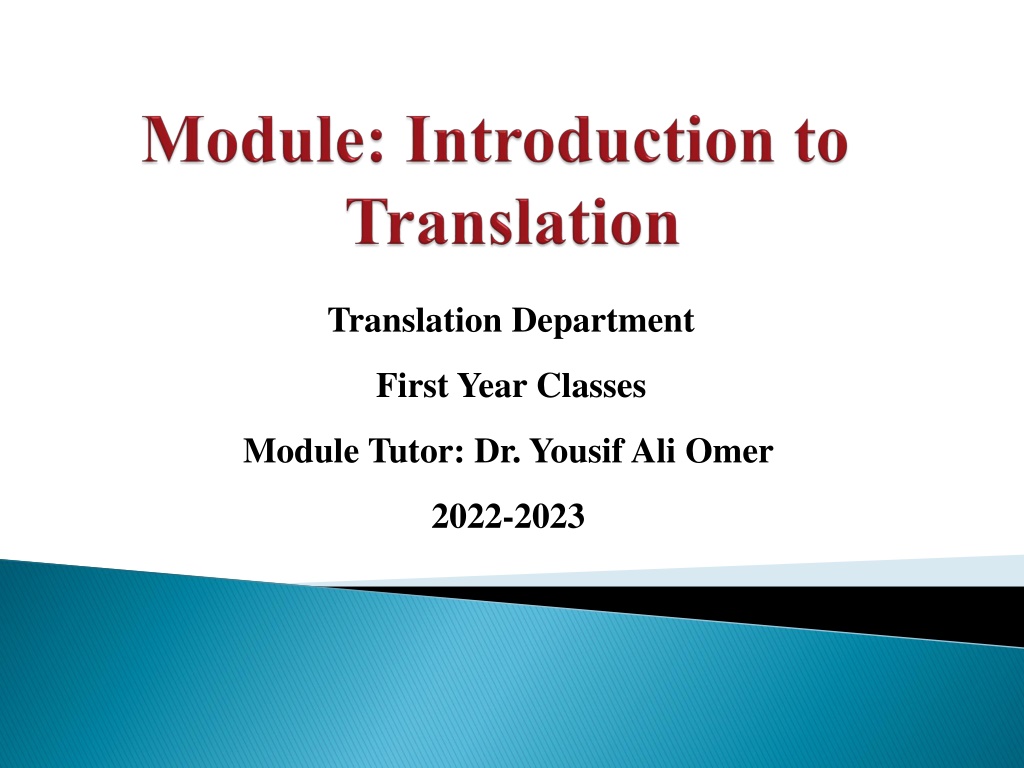
 undefined
undefined



